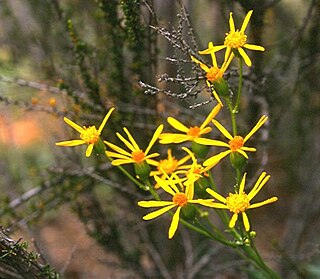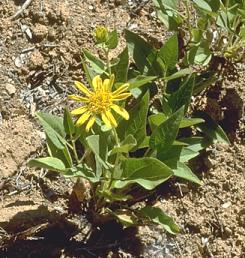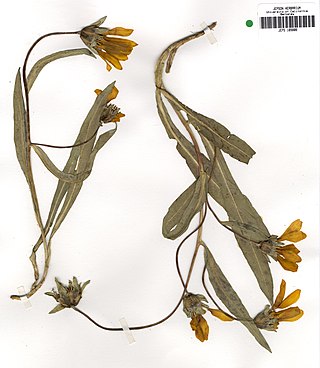Coreopsis stillmanii is a species of flowering plant in the family Asteraceae known by the common name Stillman's tickseed. It is endemic to California, where it grows in the Central Valley and most of the adjacent coastal and inland mountain ranges in California chaparral and woodlands habitats. It is found east of San Francisco Bay and on the eastern side of the Central Valley.

Helianthus bolanderi is a species of sunflower known by the common names Bolander's sunflower and serpentine sunflower. It is native to California and Oregon, where it grows mainly in mountainous areas, often in serpentine soils. It has been found from southwestern Oregon as well as in northern and central California as far south as Santa Cruz County, with reports of a few isolated populations in southern California.
Horkelia bolanderi is a rare species of flowering plant in the family Rosaceae. It is endemic to northern California where it is known from only a few occurrences in two or three counties. It grows in the mountain forests of the North Coast Ranges. This is a mat-forming gray-green perennial herb producing hairy erect stems 10 to 30 centimeters tall. The leaves are 3 to 8 centimeters long and are made up of hairy, toothed leaflets each one half to one centimeter long. The inflorescence holds several flowers, each with five white petals and up to 20 pistils in the center.

Astragalus bolanderi is a species of milkvetch known by the common name Bolander's milkvetch. It is native to western Nevada and parts of the Sierra Nevada in California. It grows in dry, rocky habitat on mountain and plateau.

Calamagrostis bolanderi is a species of grass known by the common name Bolander's reedgrass. It is endemic to northern California, where it grows in moist coastal habitat such as temperate coniferous forest, wet meadows and bogs, and coastal scrub.
Lessingia tenuis is a species of flowering plant in the family Asteraceae known by the common name spring lessingia. It is endemic to California, where it is known from the San Francisco Bay Area to Ventura County. It grows on the slopes of the California Coast Ranges in common local habitat such as chaparral.
Leptosiphon bolanderi is a species of flowering plant in the phlox family known by the common name Bolander's linanthus.
Diplacus bolanderi is a species of monkeyflower known by the common name Bolander's monkeyflower.

Packera bolanderi is a species of flowering plant in the aster family known by the common names Bolander's ragwort and seacoast ragwort. It is native to the west coast of the United States from Washington to northern California, where it grows in wet coastal forests and woodlands. There are two varieties of the species which differ slightly in morphology and habitat occupied; these varieties have been considered separate species by some authors. The var. bolanderi has thicker leaves, occurs farther south, and occupies more open types of habitat, than does var. harfordii. This plant in general is a perennial herb producing one to three stems up to half a meter tall. The basal leaves have blades up to 12 centimeters long which are divided into several lobes and borne on long, thin petioles. Leaves growing farther up the stem are smaller and have more lobes on their blades. The inflorescence contains several flower heads, each lined with dark green phyllaries. The head contains many golden yellow disc florets and generally either 8 or 13 yellow ray florets each over a centimeter long. The fruit is an achene tipped with a pappus of bristles.
Packera ganderi is a rare species of flowering plant in the aster family known by the common name Gander's ragwort. It is endemic to southern California, where it is known from a few occurrences in San Diego and Riverside Counties.

Packera layneae, known by the common name Layne's ragwort and Layne's butterweed, is a rare species of flowering plant in the aster family.

Wyethia angustifolia is a species of flowering plant in the family Asteraceae known by the common names California compassplant and narrowleaf mule's ears. It is native to the west coast of the United States from Washington to California, where it grows in grassland, meadows, and other open habitat. It is a perennial herb growing from a tough taproot and caudex unit and producing a stem 30 to 90 centimeters tall. The leaves have lance-shaped blades up to 50 centimeters tall. The inflorescence produces one or more large sunflower-like flower heads at the top of the hairy stem. The head has narrow, hairy phyllaries at the base. It contains up to 21 yellow ray florets each up to 4.5 centimeters long and many yellow disc florets. The fruit is an achene which may be nearly 2 centimeters long including its pappus.

Agnorhiza is a small genus of flowering plants in the family Asteraceae described as a genus in 1998. Its species had previously been considered members of either Wyethia or Balsamorhiza. The plants are native to California, with the range of one species (A. ovata) extending into northern Mexico. They are perennial herbs with sunflower-like flower heads 1 to 4 centimeters wide.

Agnorhiza reticulata, known by the common name El Dorado County mule's ears, is a rare species of flowering plant found only in a small region of north-central California.

Agnorhiza elata is a species of flowering plants known by the common name Hall's mule's ears. It is endemic to California, where it is known only from a section of the central Sierra Nevada foothills. It occurs primarily in a region stretching from Tuolumne County to Fresno County, but a few isolated populations have been found in Tulare County.

Wyethia glabra is a species of flowering plant in the family Asteraceae known by the common name Coast Range mule's ears. It is endemic to California, where it grows in the North and Central Coast Ranges. It is a perennial herb growing from a tough taproot and caudex unit and producing a stem up to 40 centimeters tall. It is hairless to hairy and glandular. The leaves have lance-shaped or oval blades up to 45 centimeters long. The inflorescence is usually a solitary flower head or occasionally a cluster of 2 or more. The head has lance-shaped leaflike phyllaries at the base. It contains up to 21 yellow ray florets each up to 5 centimeters long and many yellow disc florets. The fruit is an achene over a centimeter long, including its pappus.
Agnorhiza invenusta is a species of flowering plant known by the common names Coville's mule's ears and rayless mule's ears. It is found only in California, where it grows in the Sierra Nevada foothills as in Fresno, Tulare, and Kern Counties.

Wyethia longicaulis is a species of flowering plant in the family Asteraceae known by the common name Humboldt mule's ears. It is endemic to California, where it occurs in the North Coast Ranges and the Klamath Mountains. It grows in mountain and foothill habitat such as grassland and forests. It is a perennial herb growing from a tough taproot and caudex unit and producing a stem up to half a meter tall. It is hairless to hairy and glandular. The leaves have lance-shaped or oblong blades up to 20 centimeters long. They are glandular and have a waxy exudate that dries white. The inflorescence is usually a cluster of 2 to 4 flower heads, each with up to 10 yellow ray florets which may be up to 3 centimeters long. The fruit is an achene about a centimeter long, including its tiny pappus.

Agnorhiza ovata is a species of flowering plant known by the common name southern mule's ears. It is native to the mountains and foothills of southern California and Baja California, occurring the Coast Ranges and Sierra Nevada foothills in Tulare, Kern, Ventura, Los Angeles, Orange, Riverside, and San Diego counties in California, with additional populations in the Peninsular Ranges south of the international border.

Deinandra mohavensis, commonly known as Mojave tarplant or Mojave tarweed, is a species of flowering plant in the family Asteraceae.













